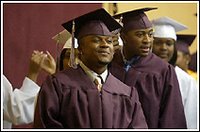Wonkitorial: Lessons To Be Learned From Private Schools
 A number of schools in and around the St. Louis area are part of a bigger movement in private school education that seems to be gathering force nationwide. Called "Nativity Schools" they're private schools that serve kids from economically disadvantaged families:
A number of schools in and around the St. Louis area are part of a bigger movement in private school education that seems to be gathering force nationwide. Called "Nativity Schools" they're private schools that serve kids from economically disadvantaged families: A framed college acceptance letter rests against a wall in the makeshift office of a small St. Louis middle school.Read the whole thing.
The letter - from Southeast Missouri State University - means the world to the man at the desk, Loyola Academy President Kevin Lee.
It represents the first of the private school's dozens of graduates to get into college.
Seven years ago, Loyola Academy opened as an experiment. Now, with three similar schools here, it is part of a national movement helping urban children enter some of the region's selective private high schools, and from there, win admission to college.
Loyola is the first in St. Louis to see its students graduate from high school.
But more are coming. The movement is expanding nationwide, and two more schools are slated to open here this fall.
The schools, most founded by Catholic religious orders, follow one model: Pick intelligent children, many of whom have not had academic success. Enroll them in small middle schools, charging tuition that each family can afford.
Start classes early each morning. Stay late each night.
Bring students back on Saturdays. Hold mandatory summer school. Teach religion and ethics. Care immensely. Then pay - at least in part - for each child's high school education.
They are known as "Nativity" schools.
Those who support them gush.
"Love, love, love them," said Robbyn Wahby, education aide to Mayor Francis Slay. "I think this is one of the most important pieces of the education puzzle in St. Louis."
As do many, Wahby sees these schools as one small step in ending a cycle of poverty, and maybe, revitalizing depressed sections of a recovering city.
Without question, Loyola has changed children's lives.Each of the four Nativity model middle schools are holding graduations this spring. All brag of successes.
Marian Middle, an all-girls school in the city's Dutchtown neighborhood, has doubled the number of eighth-grade graduates since its first group four years ago, and is now sending girls to such private Catholic high schools as Nerinx Hall and Ursuline Academy.
The five-year-old coed De La Salle Middle School, in the city's Ville neighborhood, cites awards for civic virtue and dramatic increases on the Iowa Test of Basic Skills, a common measure of progress.
And the two-year-old St. Cecilia Academy, just north of Carondelet Park, says its students' Iowa Test scores rose 10 percentile points in a year. This year's graduates are going to schools such as SLUH, Rosati-Kain High and St. John Vianney High.
School leaders say the students largely do well in high school.
"Pretty much, they come in ready to go," said Cardinal Ritter President Leon Henderson. "I've been very pleased with them."
And, some say, having urban teens mix with middle-class and wealthier suburban students makes the whole school better.
"We would like much more diversity at our school," said Sister Madonna O'Hara, president of Ursuline. "We owe that to our students." The academy will get its first Marian girls this fall.
Now, roughly 60 schools follow the model, from Washington to Durham, N.C., to San Jose, Calif.
Forty-three of them - some Catholic, some Protestant - belong to the Nativity network, and together they spend more than $39 million to educate more than 3,000 middle schoolers each year.
I think that there is much that we who work in public schools can learn from successful private schools.
For example: In private schools, not only are teachers held accountable for effectively teaching, but students are also held to high standards of behavior and effort. Teachers' expectation of students is that homework will be done on time and pupils will not be disruptive in class, thereby wasting the teacher's (and other students') valuable time. Parents are responsible for ensuring that their offspring get to school punctually, well-rested, and prepared to learn.
Which leads us to ask a question: Why aren't the public schools allowed to hold educators, students, and parents to the same high standards that seem to be working for private schools?
Food for thought.









<< Home